- Russia’s invasion of Ukraine brings geopolitical risks to the fore. As would be expected, markets are in risk-off mode, with sharp declines in equity prices around the globe.
- Looking ahead, “knock-on” effects on near-term economic prospects in the Latam region will depend on the extent to which shifts in investor risk appetite generate safe haven capital flows that trigger large currency gyrations and add to inflationary pressures via higher energy prices.
- In the days and weeks ahead, close attention will be paid to high-frequency indicators for possible inflection points signalling a potential shift in the growth profile currently incorporated into the forecasts. For now, investors are likely joining policymakers in asking “what more could go wrong?”.
KEY ECONOMIC CHARTS
Pity the policymakers. In just over a decade, they have had to deal with a global financial crisis followed by a global pandemic. And in the past year inflation has once again reared its ugly head, rising to levels not seen since the Great Inflation of the 1970s. Against that background, they could be forgiven for asking “what more could go wrong?”.
There is no shortage of possible insomnia-inducing stressors. Banks with large bond portfolios face potential revaluation effects as interest rates rise. Or non-financial firms may be subject to possible financial distress as borrowing costs rise, currency mismatches bind, and pandemic support policies are scaled back and removed. Those risks are largely hypothetical. But this week, one stressor—geopolitical risk—moved from the hypothetical to the “all-too-clear-and-present” category.
As Mao purportedly opined (but evidently did not) with respect to the French Revolution, it is too early to say what the consequences of Russia’s invasion of Ukraine will be. Markets have responded as would be expected, in “risk-off” mode, with equity markets selling off sharply in trading on February 24. Looking ahead, the knock-on effects on economic prospects will depend on the extent to which shifts in investor risk appetite generate sustained safe haven capital flows, which could trigger large currency movements, along with higher energy prices with corresponding terms of trade effects. Sharp exchange depreciations and higher energy prices would exacerbate inflationary pressures already vexing central bankers in the Latam region and around the globe.
In short, confidence bounds around short-term economic projections have undoubtedly widened. For now, however, the forecasts of Scotiabank economists in the Latam region continue to show growth converging from the “dead-cat bounce” pace in 2021 to pre-pandemic levels over the medium-term (chart 1). And while it is premature to expect the latest geopolitical effects to be reflected in economic activity indices (chart 2), these indicators will be closely monitored in the weeks ahead for potential signs of inflection points.
The same close monitoring of monthly inflation data can, likewise, be expected. Inflation, which has been running above central banks’ targets across the Latam region, is nevertheless expected to gradually return to target over time, consistent with price stability commitments (chart 3). That said, additional supply-side shocks, whether emanating from geopolitical developments or unrelated bottlenecks in global supply chains, would further test the credibility of those commitments.
Key policy interest rates have risen as Latam central banks have acted to prevent price pressures bleeding over into expectations (chart 4). While short-term expectations may be moving higher in line with headline inflation, to this point at least expectations over the medium-term seem to remain reasonably well anchored. Going forward, rates will likely have to move higher as the Fed and other advanced country central banks tighten policy, particularly if shifts in investor risk appetite lead to currency depreciation. For now, Latam central banks are clearly ahead of advanced country and other international peers in terms of real (after inflation) monetary policy rates (chart 5).
Less favourable external financial conditions would put a premium on strong institutions and sound policy frameworks. Fiscal probity is key. Fiscal balances deteriorated significantly in the pandemic as governments across the region responded quickly and appropriately to cushion the blow from economic and financial shocks (chart 6). However, good progress has been made in bringing deficits down and, looking ahead, governments have reiterated commitments to fiscal sustainability. Progress on this front will also contain debt burdens as measured by general government gross debt as a share of GDP (chart 7).
At the same time, global investors will be closely watching other indicators, including external debt (chart 8), current account balances (chart 9), and international reserves (chart 10). None point to impending concerns, though widening current account deficits in Chile and Colombia warrant monitoring.
KEY MARKET CHARTS
Despite rising inflation and increased geopolitical tensions, Latam financial markets have performed surprisingly well since the start of the year. Higher policy rates have supported regional currencies (chart 3), which, apart from Argentina’s peso, have all appreciated, with Peru’s PEN leading the way. Equity markets in Peru have likewise led the region (chart 4), shaking off serial Cabinet shuffles to post impressive year-to-date gains. Mexico’s equity market is down modestly on the year, though recent increases have pared losses.
In a longer-term perspective, Mexico has demonstrated considerable financial resilience. The peso has been remarkably stable, depreciating against the US dollar in March 2020, consistent with the shock absorber role of flexible exchange rates, but gradually returning to pre-pandemic trading levels (chart 5). In contrast, other regional currencies depreciated significantly against the US dollar at the outset of the pandemic and, while they have appreciated recently, continue to trade at a discount to pre-2020 levels.
A similar pattern holds for 10-year Latam sovereign CDS spreads versus US Treasuries. Mexican spreads spiked in March 2020, but quickly narrowed over the balance of the year and remained flat at, or below, pre-pandemic levels throughout 2021. CDS spreads on other Latam 10-year sovereigns, meanwhile, which also declined in the second half of 2020, trended somewhat higher in 2021 (more so in the case of Colombia), possibly reflecting political uncertainties.
YIELD CURVE CHARTS
Rising geopolitical risks have also thus far not shown up in Latam sovereign yield curves (charts 1–20). Sovereign curves across the Latam region have been stable since the start of 2022. Yield curves shifted up from year-ago levels over the course of 2021, consistent with higher inflation and expectations of higher short-term rates. Argentina’s sovereign yield curve remains highly inverted; Chile’s curve less so. In Brazil, yield curves have flattened.
KEY COVID-19 CHARTS
With geopolitical risks coming to the fore, attention will inevitably shift from COVID-19 risks. This shift coincides with a sharp decline in new cases both in the Latam region (chart 7) and more broadly (chart 8). Meanwhile, vaccine doses administered continues to rise, with Chile leading the Latam region (chart 10) and the world (chart 11).


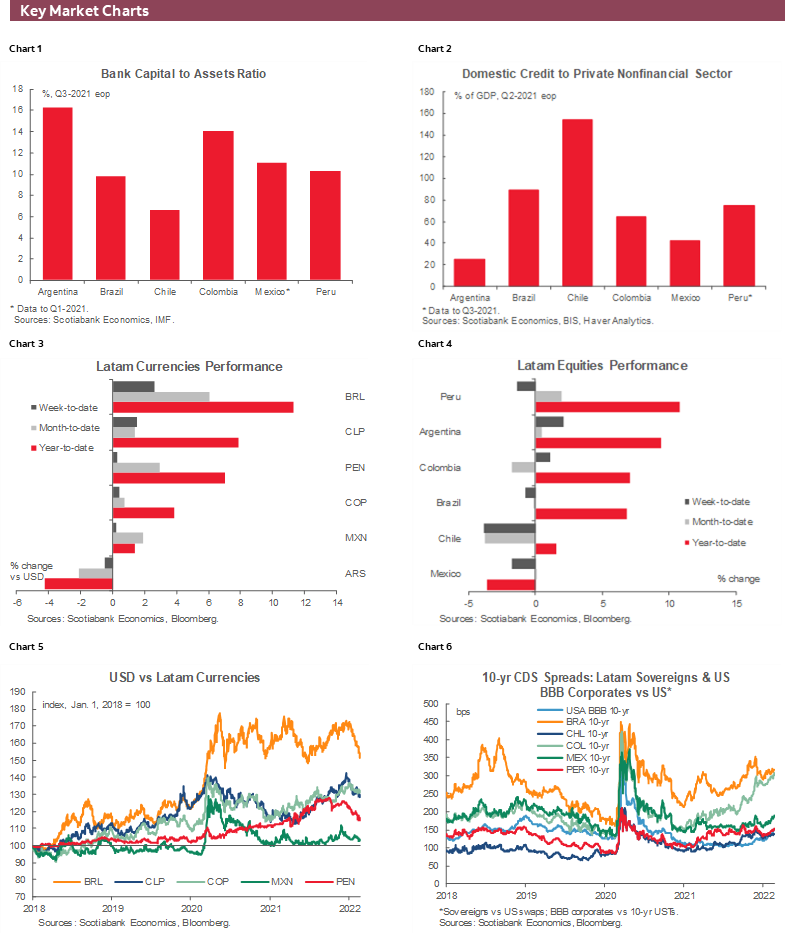
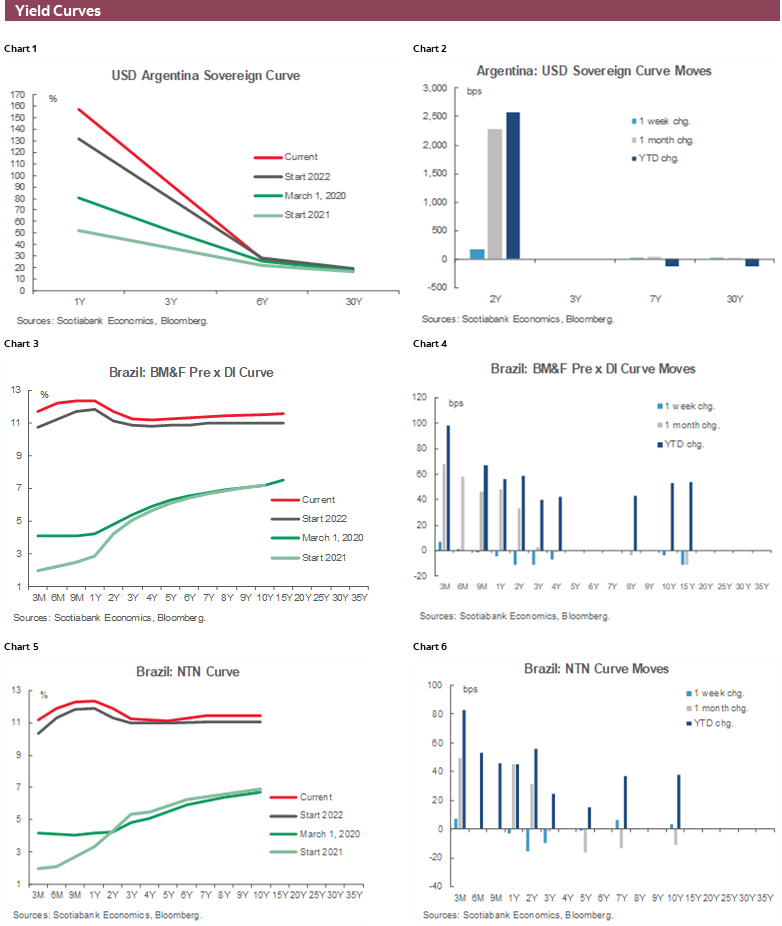
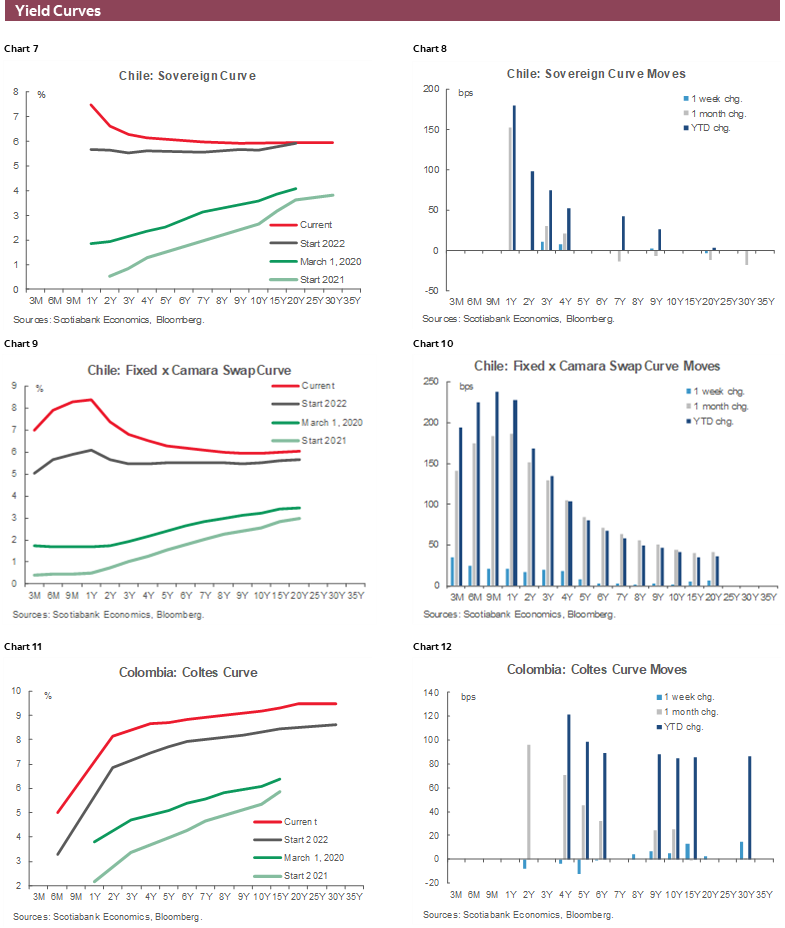
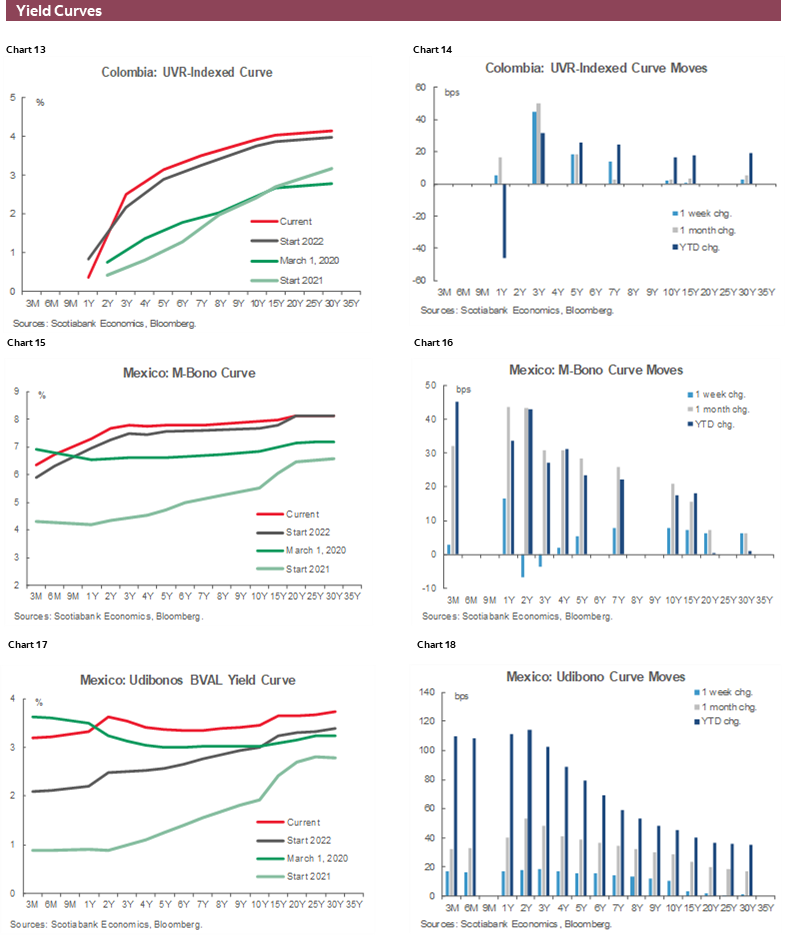
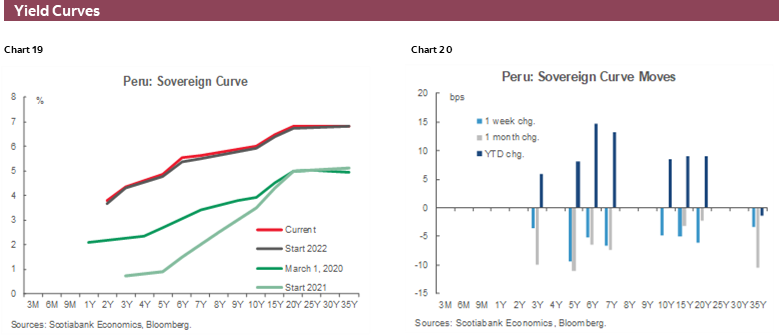
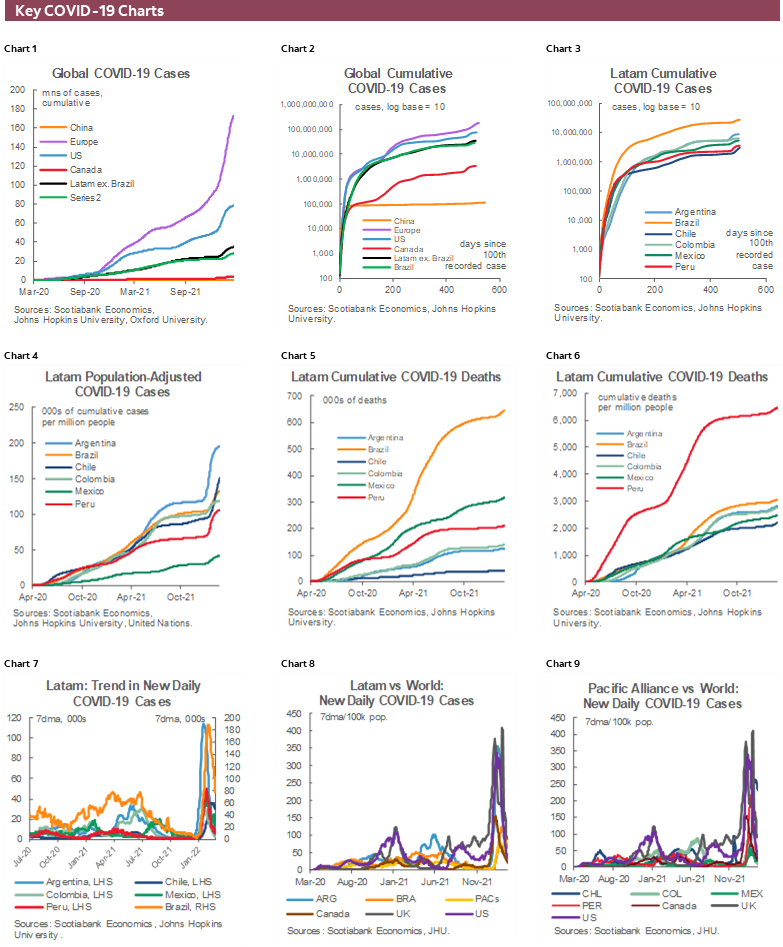
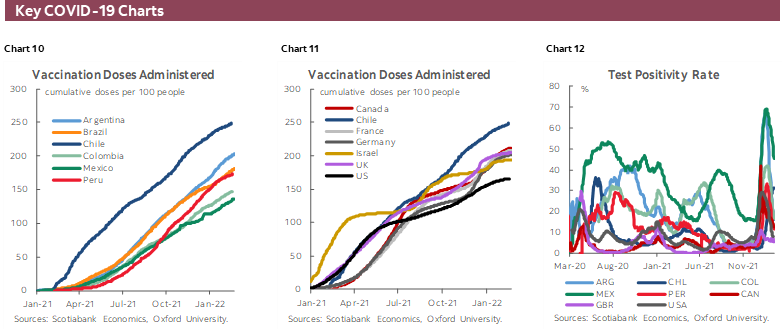
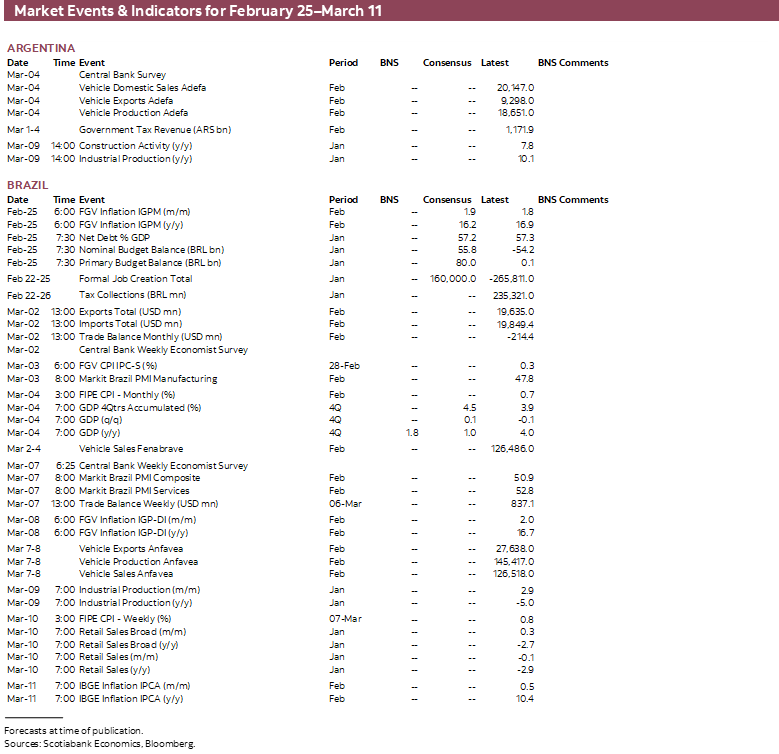
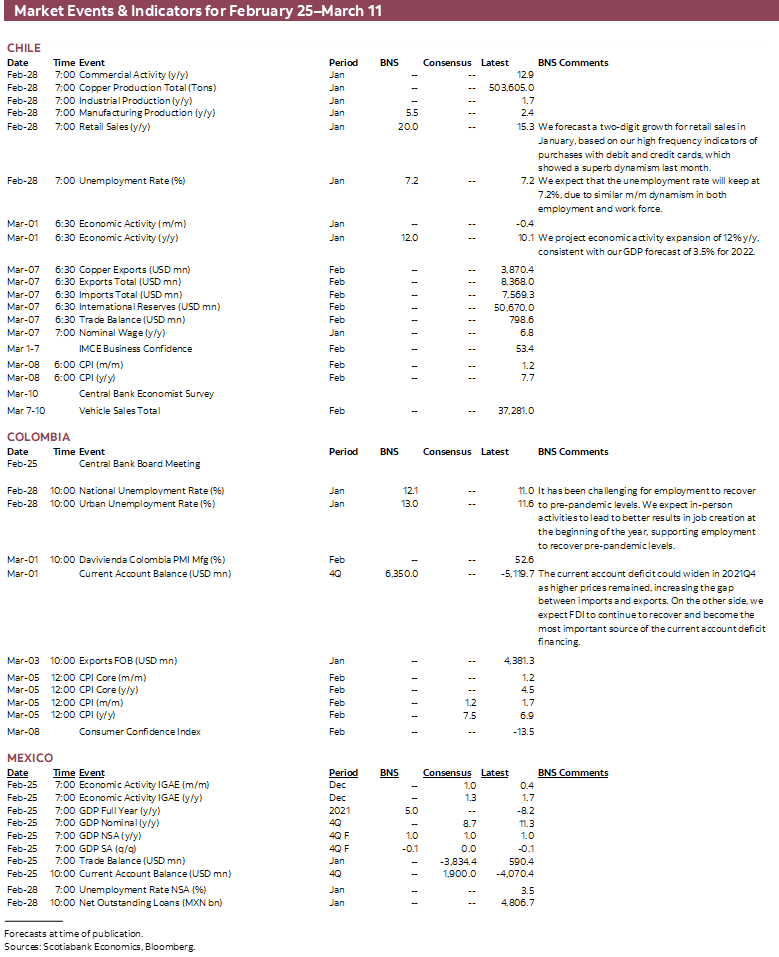
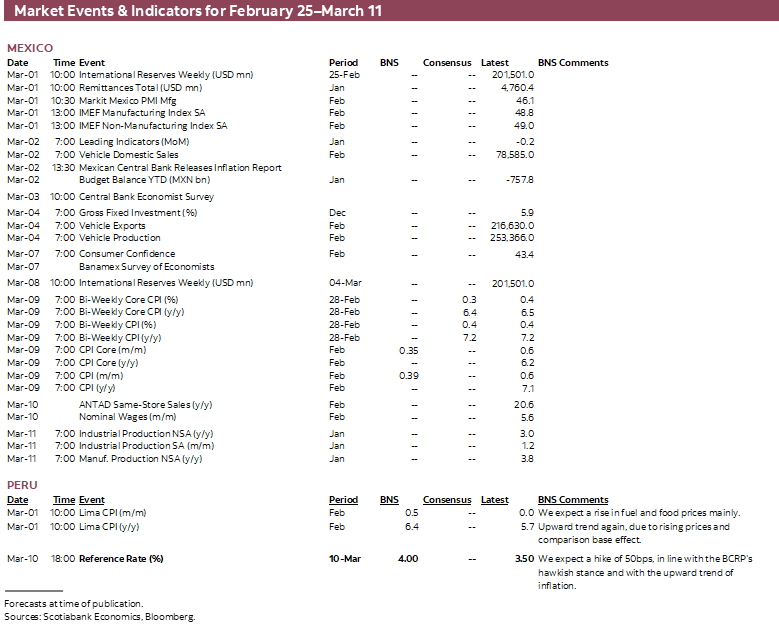
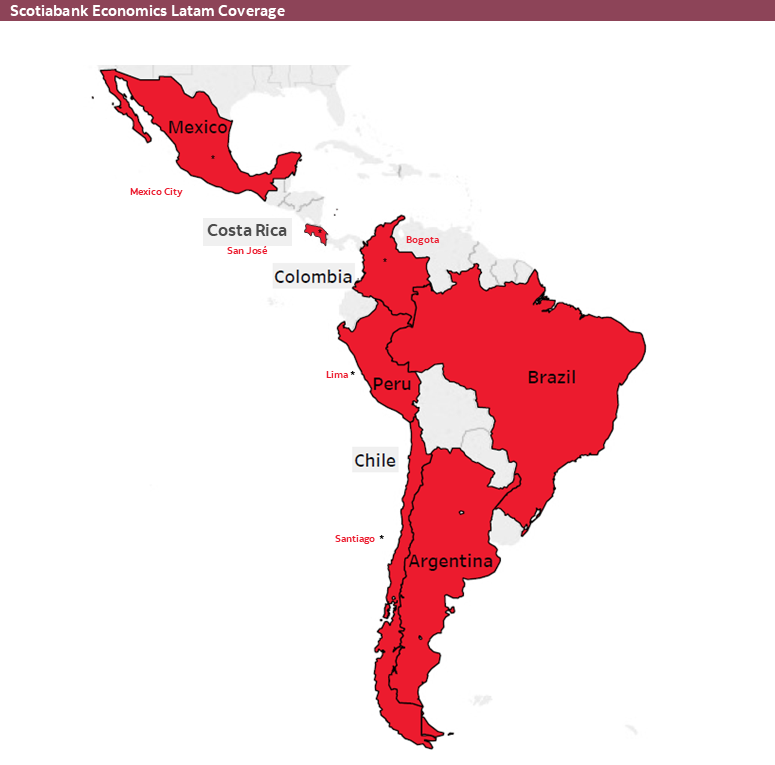
| LOCAL MARKET COVERAGE | |
| CHILE | |
| Website: | Click here to be redirected |
| Subscribe: | anibal.alarcon@scotiabank.cl |
| Coverage: | Spanish and English |
| COLOMBIA | |
| Website: | Forthcoming |
| Subscribe: | jackeline.pirajan@scotiabankcolptria.com |
| Coverage: | Spanish and English |
| MEXICO | |
| Website: | Click here to be redirected |
| Subscribe: | estudeco@scotiacb.com.mx |
| Coverage: | Spanish |
| PERU | |
| Website: | Click here to be redirected |
| Subscribe: | siee@scotiabank.com.pe |
| Coverage: | Spanish |
| COSTA RICA | |
| Website: | Click here to be redirected |
| Subscribe: | estudios.economicos@scotiabank.com |
| Coverage: | Spanish |
DISCLAIMER
This report has been prepared by Scotiabank Economics as a resource for the clients of Scotiabank. Opinions, estimates and projections contained herein are our own as of the date hereof and are subject to change without notice. The information and opinions contained herein have been compiled or arrived at from sources believed reliable but no representation or warranty, express or implied, is made as to their accuracy or completeness. Neither Scotiabank nor any of its officers, directors, partners, employees or affiliates accepts any liability whatsoever for any direct or consequential loss arising from any use of this report or its contents.
These reports are provided to you for informational purposes only. This report is not, and is not constructed as, an offer to sell or solicitation of any offer to buy any financial instrument, nor shall this report be construed as an opinion as to whether you should enter into any swap or trading strategy involving a swap or any other transaction. The information contained in this report is not intended to be, and does not constitute, a recommendation of a swap or trading strategy involving a swap within the meaning of U.S. Commodity Futures Trading Commission Regulation 23.434 and Appendix A thereto. This material is not intended to be individually tailored to your needs or characteristics and should not be viewed as a “call to action” or suggestion that you enter into a swap or trading strategy involving a swap or any other transaction. Scotiabank may engage in transactions in a manner inconsistent with the views discussed this report and may have positions, or be in the process of acquiring or disposing of positions, referred to in this report.
Scotiabank, its affiliates and any of their respective officers, directors and employees may from time to time take positions in currencies, act as managers, co-managers or underwriters of a public offering or act as principals or agents, deal in, own or act as market makers or advisors, brokers or commercial and/or investment bankers in relation to securities or related derivatives. As a result of these actions, Scotiabank may receive remuneration. All Scotiabank products and services are subject to the terms of applicable agreements and local regulations. Officers, directors and employees of Scotiabank and its affiliates may serve as directors of corporations.
Any securities discussed in this report may not be suitable for all investors. Scotiabank recommends that investors independently evaluate any issuer and security discussed in this report, and consult with any advisors they deem necessary prior to making any investment.
This report and all information, opinions and conclusions contained in it are protected by copyright. This information may not be reproduced without the prior express written consent of Scotiabank.
™ Trademark of The Bank of Nova Scotia. Used under license, where applicable.
Scotiabank, together with “Global Banking and Markets”, is a marketing name for the global corporate and investment banking and capital markets businesses of The Bank of Nova Scotia and certain of its affiliates in the countries where they operate, including; Scotiabank Europe plc; Scotiabank (Ireland) Designated Activity Company; Scotiabank Inverlat S.A., Institución de Banca Múltiple, Grupo Financiero Scotiabank Inverlat, Scotia Inverlat Casa de Bolsa, S.A. de C.V., Grupo Financiero Scotiabank Inverlat, Scotia Inverlat Derivados S.A. de C.V. – all members of the Scotiabank group and authorized users of the Scotiabank mark. The Bank of Nova Scotia is incorporated in Canada with limited liability and is authorised and regulated by the Office of the Superintendent of Financial Institutions Canada. The Bank of Nova Scotia is authorized by the UK Prudential Regulation Authority and is subject to regulation by the UK Financial Conduct Authority and limited regulation by the UK Prudential Regulation Authority. Details about the extent of The Bank of Nova Scotia's regulation by the UK Prudential Regulation Authority are available from us on request. Scotiabank Europe plc is authorized by the UK Prudential Regulation Authority and regulated by the UK Financial Conduct Authority and the UK Prudential Regulation Authority.
Scotiabank Inverlat, S.A., Scotia Inverlat Casa de Bolsa, S.A. de C.V, Grupo Financiero Scotiabank Inverlat, and Scotia Inverlat Derivados, S.A. de C.V., are each authorized and regulated by the Mexican financial authorities.
Not all products and services are offered in all jurisdictions. Services described are available in jurisdictions where permitted by law.

